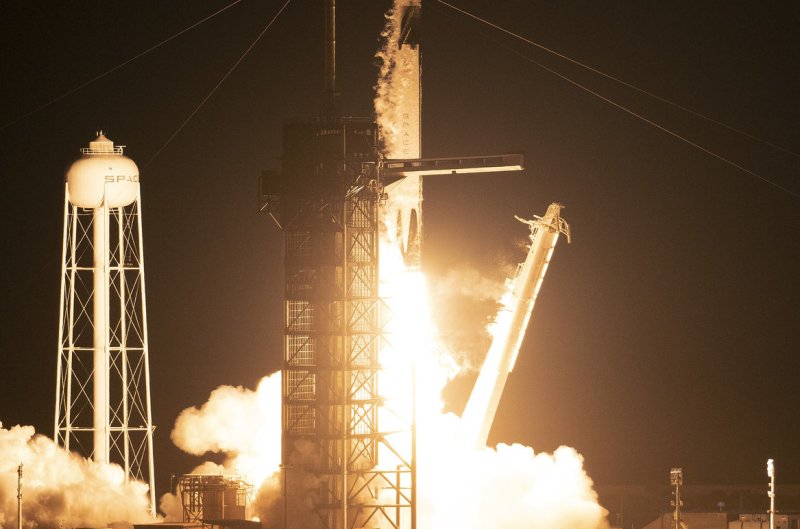1 of 3 | A SpaceX Falcon 9 rocket lifts off at 2:49 AM from Launch Complex 39A at the Kennedy Space Center, Fla., on March 2, 2019. Photo by Joe Marino-Bill Cantrell/UPI |
License Photo
March 2 (UPI) -- SpaceX's Crew Dragon began its inaugural test flight early Saturday morning. The module was carried safely into space by SpaceX's Falcon 9 rocket, which launched from Kennedy Space Center in Cape Canaveral, Florida.
"Liftoff!" SpaceX tweeted at 2:49 a.m. ET.
"The next big leap in a new chapter of U.S. human spaceflight systems has left the pad," NASA wrote on Twitter.
Shortly after liftoff, the rocket's main engine turned off and the first and second stages separated. The second stage's thrusters carried Crew Dragon into a proper orbital trajectory.
"Dragon confirmed in good orbit," SpaceX confirmed at 3:00 a.m.
A few minutes after first and second stage separation, the main stage successfully executed a controlled landing on SpaceX's droneship in the Atlantic -- the company's 35th successful landing of a rocket booster.
"Spacecraft separation!" NASA confirmed in a blog update less than 20 minutes after liftoff. "SpaceX's Crew Dragon, designed to transport astronauts to the International Space Station from U.S. soil, is flying on its own in orbit following an on-time launch."
Over the next 24 hours, the spacecraft will conduct a series of orbital phasing maneuvers. On Sunday morning, Crew Dragon will rendezvous with the International Space Station and execute a docking maneuver. The craft will remain docked for five days before de-orbiting and splashing into the Atlantic at the end of next week.
The uncrewed flight, or Demo-1 mission, will provide SpaceX the chance to prove its spacecraft is safe, reliable and ready to carry live astronauts.
The launch marks the first under NASA's commercial crew program. NASA selected SpaceX and Boeing to design and build crew-carrying spacecraft to shepherd astronauts to and from the space station -- replacements for the Space Shuttle, which NASA retired in 2011.
Both SpaceX's Crew Dragon and Boeing's Starliner were supposed to conduct their first test flights last August. But summer and fall came and went with neither spacecraft leaving the ground.
NASA is anxious for reliable transit to and from the space station. Currently, the space agency and its astronauts rely on Russian rockets and crew capsules to ferry Americans to and from ISS -- an agreement with Roscosmos that ends in early 2020.
Though Demo-1 is astronaut-free, Crew Dragon is carrying one lifeless -- but lifelike -- passenger, a dummy outfitted with a variety of sensors so scientists can measure the forces exerted on the body during the mission. SpaceX engineers dubbed the dummy Ripley, a nod to the movie Alien.
Crew Dragon is also carrying 400 pounds of supplies and equipment, which will be unloaded once the module autonomously docks at the space station.
During the mission, SpaceX will test a variety of systems and components: the module's environmental control systems, solar arrays, electrical power systems, communication systems, propulsion systems and more.
If all goes smoothly, Crew Dragon could conduct a second test flight, with live crew, as soon as April.















